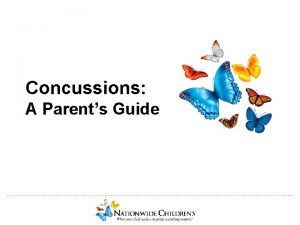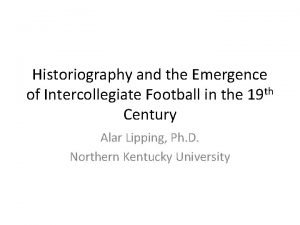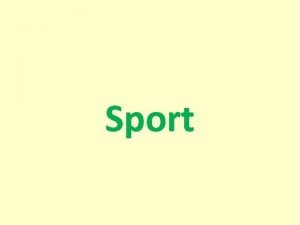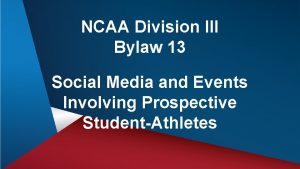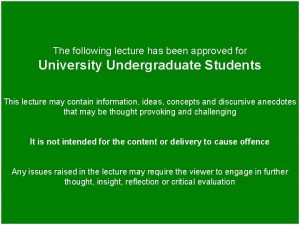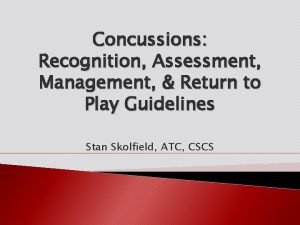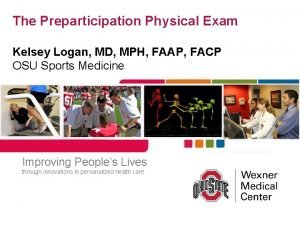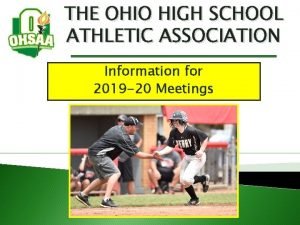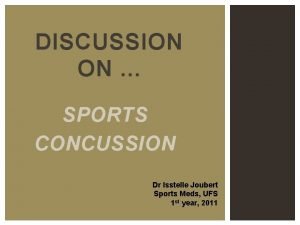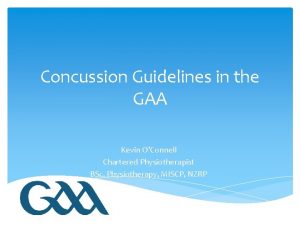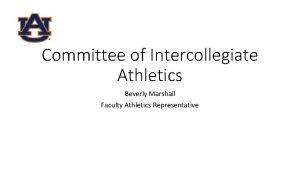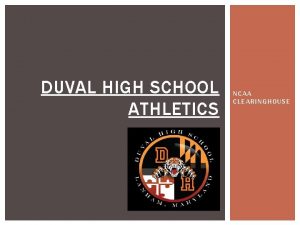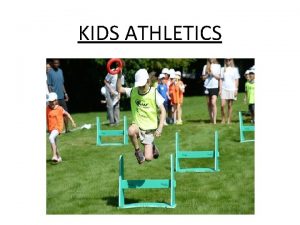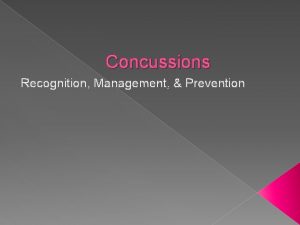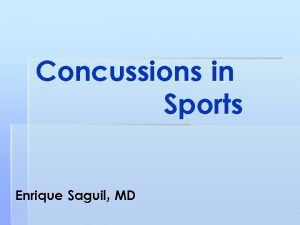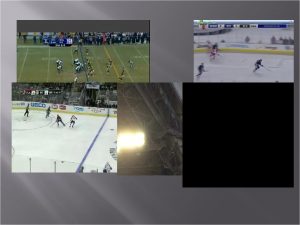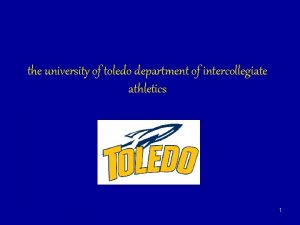Concussions in Intercollegiate Athletics NCAA Concussion Policy and











- Slides: 11

Concussions in Intercollegiate Athletics

NCAA Concussion Policy and Legislation NCAA Concussion Rule - Adopted 8/12/2010 • An active member institution shall have a concussion management plan for its student-athletes. The plan shall include, but is not limited to, the following: • An annual process that ensures student-athletes are educated about the signs and symptoms of concussions. Student-athletes must acknowledge that they have received information about the signs and symptoms of concussions and that they have a responsibility to report concussion-related injuries and illnesses to a medical staff member;

NCAA Concussion Policy and Legislation • A process that ensures a student-athlete who exhibits signs, symptoms or behaviors consistent with a concussion shall be removed from athletics activities (e. g. , competition, practice, conditioning sessions) and evaluated by a medical staff member (e. g. , sports medicine staff, team physician) with experience in the evaluation and management of concussions; • A policy that precludes a student-athlete diagnosed with a concussion from returning to athletics activity (e. g. , competition, practice, conditioning sessions) for at least the remainder of that calendar day; and • A policy that requires medical clearance for a student-athlete diagnosed with a concussion to return to the athletics activity (e. g. , competition, practice, conditioning sessions) as determined by a physician (e. g. , team physician) or the physician's designee.

Concussion Overview Presentation NCAA Concussion Video (10 min) http: //s 3. amazonaws. com/ncaa/web_video/health_and_safety/ concussion/concussion. html

Concussion Education • Insert your own institutional methods of student-athlete education on reporting symptoms and personal responsibilities • Insert your own institutional methods for coaches education on concussion management • Consider using the NCAA Educational information for student athletes & coaches as a component of the educational information • Consider CDC site for additional educational information for athletes, coaches, parents & healthcare providers

Concussion Education – Consider using the NCAA Interassociation Consensus documents for year-round football practice contact for college student-athletes recommendations for practice parameters that address safety and head impact exposure in football.

Concussion Identification/Management Institutional Methods for Identifying Possible Concussions • Insert methods used by your institution to identify potential concussions and specific tests • All student-athletes who are experiencing signs, symptoms or behaviors consistent with a sport-related concussion, at rest or with exertion, must be removed from practice or competition and referred to an athletic trainer or team physician with experience in concussion management.

Concussion; Signs & Symptoms Table 2: Selected acute & delayed signs & symptoms suggestive of concussion Cognitive Somatic Affective Sleep Disturbances Confusion Anterograde amnesia Retrograde amnesia Loss of consciousness Disorientation Feeling “in a fog”, “zoned out” Vacant stare Inability to focus Delayed verbal & motor responses Slurred/incoherent speech Excessive drowsiness Headache Dizziness Balance disruption Nausea/vomiting Visual disturbances (photophobia, blurry/double vision) Phonophobia Emotional lability Irritability Fatigue Anxiety Sadness Trouble falling asleep Sleeping more than usual Sleeping less than usual Team Physician Consensus Conference, Herring et al, 2011

Concussion Management Home Care Guidelines Following a Concussion • Insert your institutional recommendations for student-athlete home care and monitoring following a concussion

Concussion Management Progression of Return to Play • • Insert institutional recommendations for step-wise return to play criteria. Once a concussed student-athlete has returned to baseline level of symptoms, cognitive function and balance, then the return-to-play progression can be initiated Consider providing a template, as below, suggesting that progression should be gradual, and that the time spent at each stage should be individualized (from Vienna Guidelines ’ 01, Zurich ‘ 09) Medical clearance must be determined by the team physician/physician designee, or athletic trainer in consultation with a team physician.

Additional Resources Consensus Statement on Concussion in Sport http: //www. nata. org/sites/default/files/attr-44 -04 -434. pdf Year Round Football Practice Contact Recommendations http: //www. ncaa. org/sites/default/files/Year%20 Round%20 Football%20 Practice%20 Contact%20 Recommendations_2017011. pdf Management of Sport Related Concussion http: //www. nata. org/sites/default/files/Mgmt. Of. Sport. Related. Concussion. pdf
